The History Of Mercedes G400

For G-class stars, see Stellar classification.
The Mercedes-Benz G-Class or G-Wagen, short for Geländewagen (or cross-country vehicle), is a four-wheel drive vehicle / sport utility vehicle (SUV) produced by German automaker Mercedes-Benz. It was borne by proposals for a military vehicle in the early 1970s by the Shah Mohammad Reza Pahlavi of Iran, a major Daimler-Benz shareholder. Developed in co-operation with the Austrian car manufacturer Steyr-Daimler-Puch, production of the G-Class began in 1979 with the 460 Series models. The G-Class has been sold under the Puch name in certain markets, and the Peugeot P4 is a variant made under license, with a Peugeot engine and other equipment.
Mercedes-Benz secured military contracts for the vehicle in the late 1970s and offered a civilian version to the public in 1979. Designed to be a durable, reliable, and rugged off-roader, the G-wagen utilizes three fully locking differentials (one of the few vehicles sold in the U.S. to have such, along with the Jeep Wrangler Rubicon, Toyota 80-series Land Cruiser, Pinzgauer High Mobility All-Terrain Vehicle, and Mercedes-Benz Unimog). Among the engines offered in the G-Class for the 2004 model year is a 5.5-litre V8.
Marking its 25th anniversary, the 2005 Mercedes-Benz G55 AMG was relaunched as the G55 Kompressor or G55K and received a boost in power, thanks to a 5.5-liter, supercharged V8 developing 469hp (350kW) and 516lb·ft (700N·m). of torque.
The G-Wagen was first offered for sale in 1979 and redesigned in 1990/ 1991. A new version was expected for 2007, but the new GL-Class will not replace the G-Wagen and it will continue to be hand-built in Graz, Austria at an annual production rate of 4,000 to 6,000 units.
W460
The original W460 G-Wagen went on sale for civilian buyers in the model year 1979. It was offered with two wheelbases, a short wheel base (SWB) of 2400 mm and a long one (LWB) of 2850 mm. One could choose between three body styles: A 2-door SWB convertible, a 2-door SWB wagon and a LWB 4-door wagon. The two wagons were also available as windowless 2-door Van (or 'Kastenwagen' in German). During the G-wagens impressive life span many a different body style was made for army and public-service clients, like the Popemobile, the pickup or the chassis/ cab with a wheel base of 2850, 3120 or 3400 mm, the chassis/ cab being the base vehicle for army-ambulances or communication vehicles. Please note that, because of the sheer variety of military versions, this article is mainly about the somewhat more standardized civilian G-Wagen.
The W460 was popular with military and off-road enthusiasts, with more than 50,000 built in the first decade. The vehicle was not offered in the United States officially, but by means of "casual importation" grey-market in the mid-1980s, importers were successful in selling some G-Wagens (mostly W463s) that had been modified to meet US DOT specifications for around $135,000.
W461
The production of the W460 ended August 1991. It was replaced by the all but identical W461. Initially, engine choices were limited to the four cylinder 230GE petrol- and five cylinder 290GD diesel engine. The W460 'cabrio' version was skipped. From 1997 the W461 sported a slightly updated interior with better seats, changed door panels and an updated dash. From this time, the W461 was only available as 290GD Turbo Diesel with 4-speed automatic transmission. The petrol engine was dropped. Disc brakes all around became standard and the bell-housing of the front axle was changed to accommodate larger reduction-gears. The exterior and other mechanics changed little, not even the model badge which kept indicating 290GD.
The main technical difference between the W460/ 461 and W463 model, apart from the choice of engines, gearboxes and heavy-duty suspension, is the layout of the drive train. Whilst the W463 offers full-time 4WD, the W460/ 461 is basically rear wheel drive with manually selectable 4WD. This means that these models do not have a centre differential, thus no centre diff-lock. Only front and rear locking differentials are needed to obtain a fully locked drive train. The front lockers were not fitted as standard, but as a factory-fitted option. The difflocks are manually operated using hydraulic levers next to the transfer case selector handle. Other differences between W460/ 461 and W463 models are mainly cosmetic. From the front, the W460/ 461 can be easily recognized by its grille and headlight covers which differ slightly from the W463 and are always black (on a factory standard car), even if the rest of the bodywork is not. If fitted, wheel arch extenders are made of unfinished plastic, thus also black. Furthermore are the rear view mirrors mounted on the front doors instead of being mounted at the base of the A-pillar. The model badge is integrated in the base of the mirror. Finally, from behind, the biggest differences are the fuel cap, which is not covered on the W460/ 461, and the arrangement of the taillights and bumpers. The last and most notable difference can be found inside the car. Where the W463 is very luxurious (wood/ leather/ electrics etc.), the simpler model is quite basic, with a dash and trim that closely resembles the original vehicles from the late 70's. Apart from the choice of rugged materials, some luxuries like automatic transmission (standard on the 290GD TD), power steering (standard on W461), ABS, drivers airbag, central locking, engine pre-heater, air conditioning (rare), heated seats and electric windows were available for the W460/ 461. Since 2001 the W461 is no longer available for civilian customers. With its demise the very last Mercedes-Benz sporting the old naming-scheme vanished. The 290GD TD was never rebadged as G290 TD.
W463
Main article: Mercedes-Benz W463The chassis was revised for 1990 as the W463 with anti-lock brakes, full-time 4WD and a full trio of electronically-locking differentials. The interior was totally upgraded, finished with wooden accents and optional leather upholstery.
The range was refreshed again in 1997, including the introduction of a power-topped convertible and two new engines, the 2.9L Turbo Diesel and the V6-powered (M112 motor) G320 - previous years' G320s were outfitted with the M104 I6. The V8 G-wagen returned with a new engine in 1998 as the G500, with official sales beginning in the United States in 2002 at $75,000. The 349hp (260kW) G55 AMG cemented the vehicle in the American market with many snapped up by celebrities. The most powerful V8, the 476hp (355kW) (later 500hp (370kW)) G55 AMG Kompressor, introduced in 2004 as model year 2005, is able to hit 60mph (100km/ h) in just 5.4 seconds. In 2005 M-B was considering that it would be the LAST YEAR they would import the Geländewagen into the USA market. They even launched a "Grand Edition" (something they like to do to sell off the last of a particular model). One reason it was supposedly continued in the US market was because of a order placed for some 160+ diesel units for the US Marine Corp (H1 HumVees don't fit well in the V-22 Opsrey). t2005 was the FIRST YEAR the G55 AMG model boasted 469 HORSEPOWER, a 120 HP increase over the '03 and '04 AMG models.
The new G500 has a 382 horsepower 5.0 liter V8 engine, while the G55 AMG has a 476 horsepower 5.5 liter V8 engine. The G500 gets from 0 to 60mph in 6.0 seconds, while the G55 AMG takes a mere 4.8 seconds.
The W463 client had a larger choice of engines, the preliminary apex being the V8-powered 500GE in 1993. This catered more of a luxury than off-road crowd with only center and rear differential locks and an even more luxurious cabin. The 500GE was produced in limited numbers for just two years. All W463 G-Wagens began using Mercedes-Benz's new letter-first naming scheme in 1994.
Various automobile tuners such as AMG, BRABUS, LORINSER, Carlsson (car company) and RENNtech have modified the engine and exterior with a 3.6 liter engine.
It was rumored that, with military contracts for the G-Class completed, production of the old G-wagen in Graz, Austria would cease as of 2006. However, reports state that production of the current G-wagen will continue for the foreseeable future, alongside its once-intended replacement, the GL-Class (X164). An outcry among enthusiasts who admired the G-Class for its tremendous off-road potential showed that a market still existed for such a vehicle. Mercedes-Benz elected to continue G-Class production for the hardcore off-road market, while the larger 3-row GL-Class would be marketed as a competitor for the likes of the Cadillac Escalade and Lincoln Navigator.
As of July 2006, Mercedes-Benz announced a late-availability 2006 model year G-Class on its website. The company also showed a facelifted 2007 model at the Paris Auto Show in September 2006 and increased the power of the G 55 AMG version from 476 to 500hp (370kW). Currently the 2009 G 500 and G 55 AMG is offered for sale at the 30-year Anniversary of the G Class. Both models with cosmetic upgrades most noticeable with the new grill, rims, etc. Mercedes-Benz has announced that the G-Class will continue to be manufactured through 2012 due to continued good worldwide demand including for military purposes.
Argentina The Argentine Army uses the MB-230G (short and long chassis) since the 1980s, in different roles; some 900 remain in service. Australia In 2007, Mercedes-Benz won a contract to provide 1,100 G-Class vehicles to the Australian Defence Force. Austria The Austrian Army has been a long time user of various Puch G models. Bulgaria The Bulgarian Army has signed a deal with Mercedes-Benz for the supply of various G models (mostly armed) as part of its on-going modernization plan. Canada A total of 1,159 vehicles have been ordered by the Canadian Army beginning in late 2003. An armoured kit can be fitted (or removed) in 8 hours by three soldiers. Their light armour has been criticised for leading to loss of life in Afghanistan, however it is considerably better than the Iltis predecessor. Delivery of these vehicles to Reserve units has also begun; they will be employed in armoured reconnaissance units. It is in the final stages of fully replacing the Iltis in most units as the armoured reconnaissance vehicle in use LFCA. Other units will replace the Iltis with a militarized Chevrolet Silverado known as the MILCOTS (or colloquially as the "Milverado".) :For the most exposed missions in Afghanistan 75 RG-31 Nyala built by BAE Land Systems OMC, South Africa, will be used. Croatia Croatia bought 300-320 vehicles for needs of Croatian army and for peacekeeping operations missions in Afghanistan additional 30 RG-31 vehicles were delivered. Croatia uses mix of 4x4 vehicles in peacekeepings operations and Mercedes G class is very popular choice within the Croatian Army. G class are supplemented by Land Rover Wolf and Iveco LRV vehicles. Denmark The Danish military bought the 240 GD (/ 24, / 28 and / 34 variants) to supersede the M151A1, the Volkswagen 181 ("Jagdwagen") and the Land Rover 88. First deliveries of the 240 GD were in 1985 and later the 290 GD (/ 24 and / 28 variants) where also introduced. More than 1.300 have been put in service. A few 300 GE's have also been used - mainly by the Danish army EOD-services. Currently the Danes are taking delivery of over 2.000 270CDIs in several variants, starting in 2003. Estonia The Estonian Defence Forces have a small number of various G-Class vehicles, which were recently purchased to replace the outdated UAZ and Volkswagen Iltis jeeps. Finland The Finnish Army uses the Geländewagen mostly as armored vehicles and ambulances, but other versions are also in service. France The French Army have the Peugeot P4 which is a derivative from the G-Class equipped with Peugeot engine and equipment. Germany The German Armed Forces uses the G-Class under the name "Wolf". Over 12,000 vehicles have been delivered in over 50 versions, ranging from ambulance vehicles to armored vehicles used by the German special forces. Greece The Greek Army as well as Air Force, Navy and Police use several versions of the Geländewagen, manufactured by ELBO the Hellenic Vehicles Industry as W462. Hungary The Hungarian Ground Forces are using a small number of G-270 CDI BA 10, which is mounted with UMF light-machine gun platform.More will be purchased between 2010–2013. Ireland The Irish Army Have 60 G-Wagon troop transport vehicles. Luxembourg The Military of Luxembourg uses the 300D variant of the Geländewagen. Malaysia locally build by DRB HICOM as G-Wagon and used along with Land Rover Defender as light transport of Malaysian Army. Mexico The Mexican naval defense secretary (SEMAR) announced in 2008, A contract to purchase large numbers of Mercedes-Benz military vehicles including an up-armored variant of the G-Class "Serval" scout vehicle for the Mexican Marine corps. Netherlands The Dutch Army uses various versions of the Mercedes-Benz G-Class, mostly W461 290GD and 290GD TD models with manual gearbox. Also the Dutch police and Koninklijke Marechaussee are using the G. Most of these are armored W463 models. Norway The Norwegian Army bought 240 GD to replace Volvo and Land Rover jeeps in the mid-1980s, and 300 GD to use as ambulances. The 300GD is also used to transport the launch control station and optical sensors for the NASAMS Air-defense system. During the 90's 290 GD's where bought, and in the first half of the 00's a small number of armoured 270 CDI's were put into service. Today the Defence Forces operates a total of 3000 vehicles. The escort company of the Norwegian Royal Guard employs a black G500 AMG with police lights on the roof. Poland 121 in service with Polish Army. Serbia The Military of Serbia is using Austrian-made Puch 300GD, most of them, 204 in 300GD 6 and 300GD 3 versions bought by Yugoslav Peoples Army in 1984 as replace for FIAT-1107JD and other older vehicles. There are is also a number (some 100-150) of younger vehicles bought by Yugoslav Army in 1998. The most of Puchs are used by Military Police as patrol vehicles and as utility vehicle for transport of military personal, but also by Special Forces. Military of Serbia is use Puchs in 300GD33, 300GD6 and 300GD10 variants, for transport of VIP persons in 300GD3-LUX and 300GD6-LUX and Special Forces Brigade is use modified version designed for access to combat zone. The Serbian Ministry of Internal Affairs and Serbian Police also use a number of Puch 300GD and Mercedes-Benz G-Class vehicles as cross country patrol vehicle. Some are also used by Firefighter units and Gendarmerie (Žandarmerija) units which patrol the "Ground Safety Zone" on administrative line with Kosovo and Metohija. Singapore The Singapore Army bought the 270 and 290 versions as secondary military transport. It is used in soft-top truck configuration and is known as a 1.5-tonner or simply "MB" to its users. And also some were used also for patrolling in a jeep form. The Army also deploys the extremely short-wheelbase, soft-top version for its Colonels, Battalion COs, Brigade and Division Commanders as personal field transports. Slovenia Military of Slovenia uses mainly for transport. Switzerland The Swiss Army uses the 230 with soft top as the primary general purpose carrier, and a hardtop version as mobile radio access point. It is in service since 1985 and gradually replaced Willys Jeeps, Haflinger light transports and Pinzgauer medium transports in the liaison and transport role. All versions in Swiss Army use are unarmed. United States The USMC Interim Fast Attack Vehicle (IFAV) is a modified version of the Mercedes-Benz Geländewagen 290. It replaces the modified M-151A2 1/ 4 ton truck (MUTT jeep) used by the Marines as an FAV in the 1990s. The U.S. Marine Corps acquired 157 of the IFAVs distributed as follows:- (I) Marine Expeditionary Force (MEF) Camp Pendleton, CA (33);
- (II) MEF Camp Lejeune, NC (25);
- (III) MEF on Okinawa, Japan (27);
- (IV) 17 Force Recon, Afghanistan (22);
- (V) 3 Force Recon Bn, Iraq (23);
- (VI) 1st Provisional DMZ Police Company, Korea (15); and
- (VII) various miscellaneous (12)
- 200GE - M102E20 2.0L I4 (only sold in Italy)
- 230G - M115 2.3L I4, 102hp (75kW),??? ft·lbf (172N·m/ 3000 rpm)
- 230GE - M102E23 2.3L I4, 125hp (92kW),??? ft·lbf (192N·m/ 4000 rpm)
- 280GE - M110 2.8L I6, 156hp (115kW),??? ft·lbf (226N·m/ 4250 rpm)
- 240GD - OM616 2.4L Diesel I4, 72hp (53kW),??? ft·lbf (137N·m/ 2400 rpm)
- 250GD - OM602 2.5L Diesel I5, 94hp (69kW),??? ft·lbf (???N·m)
- G 270 CDI - OM612 2.7L Diesel I5 (turbocharged), 156hp (115kW), 294 ft·lbf (400N·m)
- 290GD - OM602D29 2.9L Diesel I5, 95hp (71kW)
- 290GD TD - OM602DLA29 2.9L Diesel I5 (turbocharged), 120hp (89kW)
- 300 GD - OM617 3.0L Diesel I5 - later rebadged G 300
- 300 GE - M103 3.0 L I6 - later rebadged G 300
- G 350 DT
- G 300 DT - OM606 3.0L Diesel I6(turbocharged), 177hp (130 kW), 244ft·lbf (330 N·m)
- G 320 - M104 3.2L I6, 217hp (161kW), 229 ft·lbf (310N·m)
- G 320 - M112 3.2L V6, 215hp (158kW), 220 ft·lbf (300N·m)
- G 320 CDI - OM642 3.2L Diesel V6, 224hp (165kW), 397 ft·lbf (540Nm)
- G 400 CDI - OM628 4.0L Diesel V8 (turbocharged), 250hp (184kW), 411 ft·lbf (560N·m)
- 500 GE - M117 5.0L V8
- G 500 - M113E50 5.0L V8, 296hp (218kW), 336 ft·lbf (456Nm)
- G 55 AMG - M113E55 5.5L V8 supercharged, 500hp (350kW), 514 ft·lbf (700N·m)
- G 63 AMG - V12 N/ A, 444hp (326kW), (620N·m/ 4400 rpm) (only 12 ever built)
Mercedes-AMG Chairman Volker Mornhinweg claims that one third of all G-Class vehicles sold to civilians are the G55 AMG model. The largest markets for G 55's are California, USA (in black and silver color mostly), and the United Arab Emirates with Dubai (in white color mostly)
From Wikipedia, the free encyclopedia
More About Mercedes G400
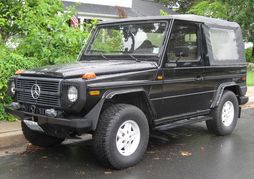
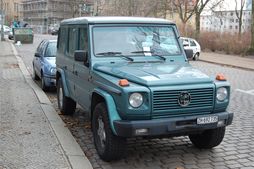
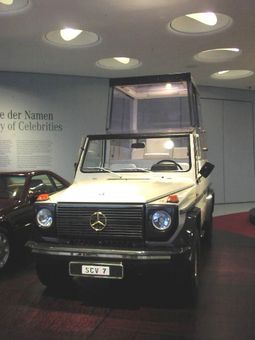
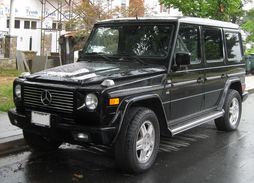
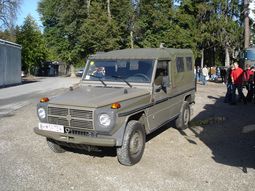
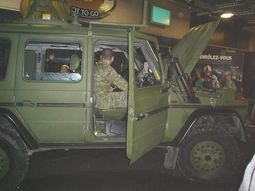
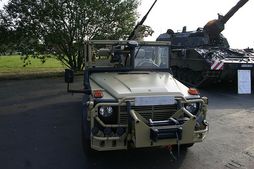
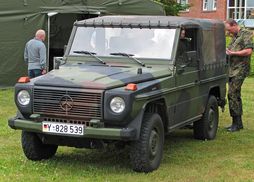
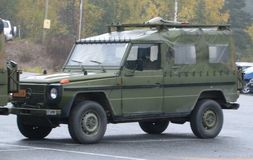
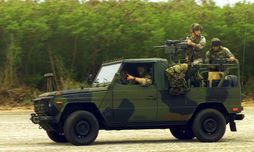
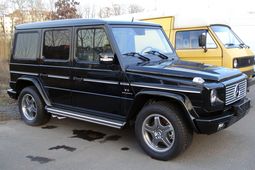
|